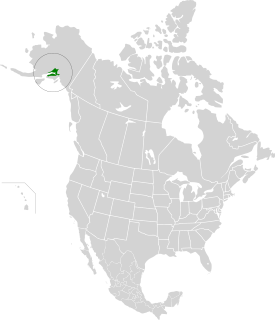
The Yukon River is a major watercourse of northwestern North America. The river's source is in British Columbia, Canada, from which it flows through the Canadian Yukon Territory. The lower half of the river lies in the U.S. state of Alaska. The river is 3,190 kilometres (1,980 mi) long and empties into the Bering Sea at the Yukon–Kuskokwim Delta. The average flow is 6,430 m3/s (227,000 ft3/s). The total drainage area is 832,700 km2 (321,500 mi2), of which 323,800 km2 (126,300 mi2) is in Canada. The total area is more than 25% larger than Texas or Alberta.

The Arctic National Wildlife Refuge is a national wildlife refuge in northeastern Alaska, United States. It consists of 19,286,722 acres (78,050.59 km2) in the Alaska North Slope region. It is the largest national wildlife refuge in the country, slightly larger than the Yukon Delta National Wildlife Refuge. The refuge is administered from offices in Fairbanks. ANWR includes a large variety of species of plants and animals, such as polar bears, caribou, wolves, eagles, and migratory birds, which rely on the refuge.

The Brooks Range is a mountain range in far northern North America stretching some 700 miles (1,100 km) from west to east across northern Alaska into Canada's Yukon Territory. Reaching a peak elevation of 8,976 feet (2,736 m) on Mount Isto, the range is believed to be approximately 126 million years old.

The Koyukuk River' is a 425-mile (684 km) tributary of the Yukon River, in the U.S. state of Alaska. It is the last major tributary entering the Yukon before the larger river empties into the Bering Sea.

The Gwichʼin are an Athabaskan-speaking First Nations people of Canada and an Alaska Native people. They live in the northwestern part of North America, mostly above the Arctic Circle.

Yukon is in the northwestern corner of Canada and is bordered by Alaska and the Northwest Territories. The sparsely populated territory abounds with natural scenic beauty, with snowmelt lakes and perennial white-capped mountains, including many of Canada's highest mountains. The territory's climate is Arctic in the north, subarctic in the central region, between north of Whitehorse and Old Crow, and has a humid continental climate in the far south, south of Whitehorse and in areas close to the British Columbia border. The long sunshine hours in the short summer allow a profusion of flowers and fruit to blossom. Most of the territory is boreal forest, tundra being the main vegetation zone only in the extreme north and at high elevations.

The Porcupine caribou or Grant's caribou is a subspecies of the reindeer found in Alaska, United States, and adjacent parts of Canada. It resembles the subspecies known as the barren-ground caribou and is sometimes included in it.

The Yukon Flats National Wildlife Refuge is a protected wetland area in the U.S. state of Alaska. It encompasses most of the Yukon Flats, a vast wetland area centered on the confluence of the Yukon River, Porcupine River, and Chandalar River. The area is a major waterfowl breeding ground, and after a proposal to flood the Yukon Flats via a dam on the Yukon River was turned down, the Yukon Flats were deemed worthy of protection. The Alaska National Interest Lands Conservation Act established the refuge in 1980. It is the third-largest National Wildlife Refuge in the United States, although it is less than one-half the size of either of the two largest, the Arctic National Wildlife Refuge, or the Yukon Delta National Wildlife Refuge. The refuge is administered from offices in Fairbanks.

Kanuti National Wildlife Refuge is a national wildlife refuge in central Alaska, United States. One of 16 refuges in Alaska, it was established in 1980 when Congress passed The Alaska National Interest Lands Conservation Act (ANILCA). At 1,640,000 acres (6,600 km2), Kanuti Refuge is about the size of the state of Delaware. Located at the Arctic Circle, the refuge is a prime example of Alaska's boreal ecosystem. It is dominated by black and white spruce, with some white birch and poplars.

The Koyukuk National Wildlife Refuge is a 3,500,000-acre (14,000 km2) conservation area in Alaska. It lies within the floodplain of the Koyukuk River, in a basin that extends from the Yukon River to the Purcell Mountains and the foothills of the Brooks Range. This region of wetlands is home to fish, waterfowl, beaver and Alaskan moose, and wooded lowlands where two species of fox, bears, wolf packs, Canadian lynx and marten prowl.

The Alberta Mountain forests are a temperate coniferous forests ecoregion of Canada.

The Alberta-British Columbia foothills forests are a temperate coniferous forests ecoregion of Canada. This ecoregion borders Canada's taiga and contains a mix of subarctic forest and temperate forest species as a result. This makes the region an ecotone region, or a region that acts as a buffer between two other biomes.

The Cook Inlet taiga ecoregion, in the Taiga and Boreal forests Biome, is located in Alaska.

The Copper Plateau taiga is an ecoregion of North America, as defined by the World Wildlife Fund (WWF) categorization system and the Commission for Environmental Cooperation, in the Taiga and Boreal forests, Biome, Alaska.

The Eastern Canadian Shield taiga is an ecoregion of Canada as defined by the World Wildlife Fund (WWF) categorization system.
The Yukon Interior dry forests is a taiga ecoregion of Canada.
The Muskwa-Slave Lake forests is a taiga ecoregion in Canada.
The Mid-Continental Canadian forests are a taiga ecoregion of northern Canada.

The Arctic coastal tundra is an ecoregion of the far north of North America, an important breeding ground for a great deal of wildlife.

The Beringia upland tundra is a mountainous tundra ecoregion of North America, on the west coast of Alaska.

















